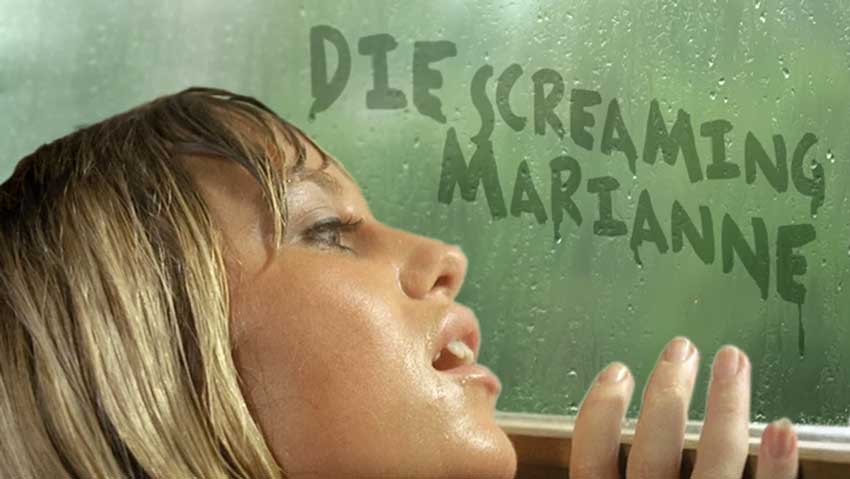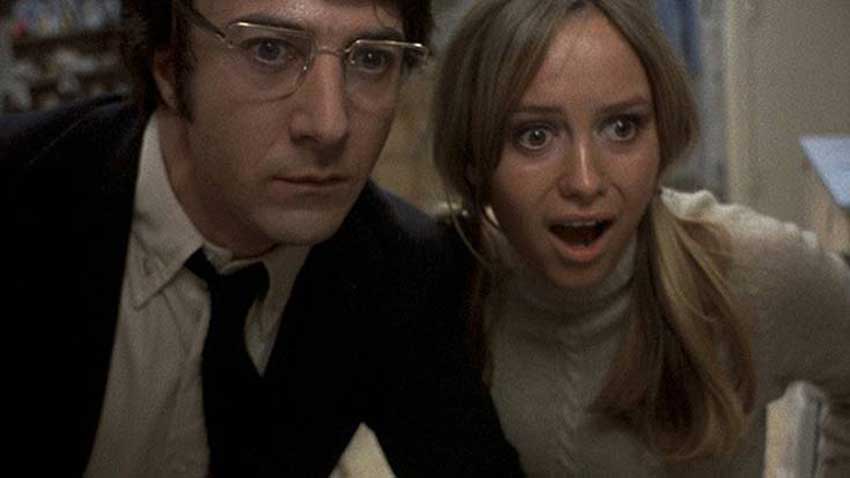Scream, You’re a Star: Susan George in 1971
By Brian Greene
October 17, 2019
Susan George (born 1950) had a string of movie roles under her belt before 1971. In those early film appearances, the gorgeous blonde with the alluringly pretty eyes and nice legs was sometimes used largely as cinematic eye candy. And while there were varying degrees of more dramatic roles for George through that slew of releases, her parts in a trio of films that came out in ’71 were more substantive than the ones she’d previously played. They created a turn in her career, one that made her a star.
She portrayed major characters in each of the three aforementioned feature films that hit theaters that year, one of them made by a leading light director and co-starring one of the most noteworthy male leads of the era. She quickly became a viable leading lady. With one of those movies, Fright, having been just released in a deluxe Blu-Ray edition by Shout! Factory, it’s a timely moment to look at this pivotal year in the acting life of a cinematic luminary of the ‘70s.
The first of the trio to be released theatrically was Die Screaming Marianne. This title is often referred to as a horror movie, but that’s inaccurate, as it’s better described as a suspenseful thriller. Its director is Pete Walker, who’s known for making sex and horror exploitation films and who has referred to himself as “the uninvited guest of the British film industry.” George portrays the titular character, a 20-year-old girl who lives in different parts of Europe and works as an exotic dancer in nightclubs.
The plot of DSM starts with a corrupt British judge, who made a fortune by taking in large sums from interested parties in exchange for reducing prison sentences of convicted criminals. The judge eventually got booted off the bench but was never charged with a crime. He currently presides over a lush Portuguese villa, which also houses his older daughter, who is as vicious as she is psychologically unstable.
The mother of Marianne (the judge’s younger child) and her sister left the judge several years before and was apparently murdered not long after. But she managed to haul a load of her and the judge’s money into a Swiss bank account and made arrangements for that fund to come into Marianne’s possession when Marianne turns 21. Marianne bolted from her sinister father and creepy sister when she was 15, and she has been on her own since. Now that she’s about to turn 21 and come into possession of the stashed funds, her father and sister—who want that money—use various means to lure her to Portugal. And that’s when things get really tense.

Reviews of DSM are generally negative. It’s been called a “pedestrian pulp thriller,” and there are gripes against its rambling plot and some of the lifeless acting. There’s some validity to the criticisms of this film, yet it’s an enjoyable watch, despite itself. Judy Huxtable is superb as the evil sister. Leo Genn (a poor man’s James Mason) is fun to watch as he plays the judge—if only for the fact that he always seems to be about to burst out in laughter while delivering his gravely serious lines.
It’s true that some of the supporting actors could have stood from a little more pep in their performances. But anyone who charges George with coming off as flat in her portrayal of Marianne should consider the character’s life circumstances. If your beloved mother had been murdered years before, if your father and sister wanted to take money that’s coming to you and would probably prefer you to be dead, and if you’d been living as an orphan getting by via flashing your bodily goods for lustful punters, would you be bouncing around with limitless joie de vivre? There’s much to like in Marianne as she’s played by George. She’s a moody pessimist, sure, but she’s also a fiercely independent free spirit who dresses groovy.
The other two films to be discussed here were released in theaters around the same time, near the end of calendar year 1971. Neither were feel-good holiday fare for families to enjoy together. Let’s discuss Fright first. It was made by English filmmaker Peter Collinson, who’s best known for his directorial work on 1969’s The Italian Job.
With this title, the less plot details given here, the better. It’s an actual horror movie, of the babysitter nightmare variety. George plays Amanda, a college student who takes a one-time child-tending gig in a small English village some distance from the city where she lives. She’s to spend a few evening hours keeping an eye on a 2-year-old boy while his parents have a night out.
We know right away that this isn’t going to be a routine babysitting experience for Amanda. The child’s mother—played convincingly by Honor “Pussy Galore” Blackman—seems incredibly tense, and not just in the usual anxious parent way. The old house is riddled with nervous-making creaky noises. And if all of that isn’t enough to put the sitter on edge, what she learns about the family from a pesky, lustful male friend who makes an unexpected visit just about sends her into a state of terror.
It seems the fellow who appeared to be the spouse of the brittle woman of the house is not actually her husband, and the man she’s actually been married to—at least before their divorce became final (that just happened)—once attempted to murder her and is currently confined in a psychiatric hospital. Ok, enough said about the plot.

At the time of its release, critical appraisal of Fright was largely negative. Roger Ebert damned it with faint praise by calling it “a passably good thriller.” Other experts hurled a variety of insults at the film in their reviews. But time has been somewhat kind to the movie. Root around on the web and you’ll find more complimentary appraisals. Nobody’s ready to credit Collinson with achieving Hitchcockian quality via this suspenseful horror effort, but some see it as an effective film of its kind and a prototype that was an influence on later, similar features such as Halloween (1978).
Whatever number of stars anyone would give Fright in their personal rating system, it’s hard to argue with the conclusion that Collinson achieved what he meant to accomplish in making the film. It’s unnerving and sometimes difficult to stomach. You wouldn’t want your teenage daughter to see it if she ever looks after others’ children while the parents are out. But Collinson wanted it to be a scary babysitter movie, and it is.
The acting in the film is good in general, and George comes across as able and assured in playing another leading role. Those who admire her beauty will enjoy watching her in this, as she’s never looked prettier up on the big screen as she does here in a soft purple mini-dress and a pair of black boots. Shout! Factory’s new edition of Fright includes an interview with film historian Kim Newman.
If George was feeling typecast as a victim around this time, her role in Straw Dogs, the last title to be discussed here, would have fully justified her developing such a complex. Directed by Sam Peckinpah, a filmmaking maverick who often tested the boundaries of viewers’ moral sensibilities and of how much violence they could withstand in a movie, this title was controversial in its time and remains so today.
The story, which is based somewhat loosely on Gordon M. Williams’s 1969 novel The Siege of Trencher’s Farm, involves a young couple who leave their home in America to spend a length of time in a rustic village in Cornwall in the U.K. The male half of the married pair is David Sumner (played by Dustin Hoffman), a mathematics academic who’s doing research work funded by a grant. George portrays his attractive, mischievous wife, Amy, who is originally from the Cornish village. The idea is that the mathematician will be able to work in relative peace in the Cornish town, more so than he would have if they’d remained in the States during his sabbatical. That the village is his wife’s native home is just gravy for them.
But there’s acute tension in the couple’s life in Cornwall. We see this from the opening scene, and the friction only mounts more and more as the story plays out. The locals don’t care much for the math whiz. This is particularly true in the case of the greasy ruffians who have been hired to do handy-man work around the Sumners’ temporary home. For his part, Mr. Sumner isn’t exactly enamored of these fellas, either. There’s sexual tension between the lascivious workers and Amy, and one of those geezers used to be her boyfriend. And then there’s strain within the couple’s marriage, this mostly having to do with David wanting long periods to do his research work and Amy wishing he would spend more time with her and less with his notebooks and chalkboard. When the couple can’t agree about how to try to handle the escalating hostility the ruffians visit upon them, all the mental and physical tautness gets to be a combustible force.

Anyone who knows the first thing about this movie is likely aware of the fact that a crucial scene involves a particularly heinous act of violence against Amy. That’s the source of the abundant controversy that surrounds Peckinpah’s effort. Debates among film critics have raged as to whether there is some creative justification behind that scene or it’s simply an unforgivably gruesome bit of gratuitous viciousness on the director’s part. There’s no question the segment could have been shorter and less graphic. But when did the director of The Wild Bunch (1969) ever err on the sides of brevity or subtlety in filming scenes of violence?
Whatever anyone thinks of that scene—and/or the extended bloodbath that closes out the story—there’s more to perceive in how Peckinpah made this film, beyond all the pain and gore. He appears to have been making an overarching statement, one he channeled through the voice of Amy. In an early scene, she makes a damning accusation against David during one of their arguments. She claims he really came to Cornwall in an act of moral cowardice because he didn’t want to have to take a stand in all the vital social and political controversies in the U.S. at the time, including the war in Vietnam. It’s as if some kind of karmic justice is coming down on the professor and his wife for being in a place where they don’t belong and for having come there for the wrong reasons.
Whether the violent parts of Straw Dogs are deal-breakers for any viewers, anyone can see that the director of this movie was a master at what he did. The other two features under discussion here both have their relative good qualities, as described above, but neither are in the same world as Straw Dogs in terms of strength of cinematic artistry. And Susan George had now played a critical role in a major film made by an acclaimed director and starred alongside one of the biggest male leads of the day. She had arrived.
What became of George’s acting career after this year? Some of her most notable later roles include major parts in the midnight movie favorite Dirty Mary, Crazy Larry (1974) and the (rightfully) critically panned historical drama Mandingo (1975). 1975’s Out of Season doesn’t get talked about as much as those two, but it’s an oddly captivating feature that also stars Cliff Robertson and Vanessa Redgrave and concerns a particularly bizarre love triangle.
After the ‘70s, George’s roles slowed down and then ground to a halt following the ‘80s. In more recent times, she has turned her attention to endeavors such as horse breeding and a charitable organization dedicated to providing aid to those living with cancer. On her website, it’s stated that she’s at work on an autobiography. Hopefully, that book will give extensive coverage of her acting career in 1971 because that year was the one that made her a recognizable star of the screen.
Comments are closed.

This is a good movie and worth watching. I really like and appreciate this movie.
This is a great movies and as always keep up the good work !!